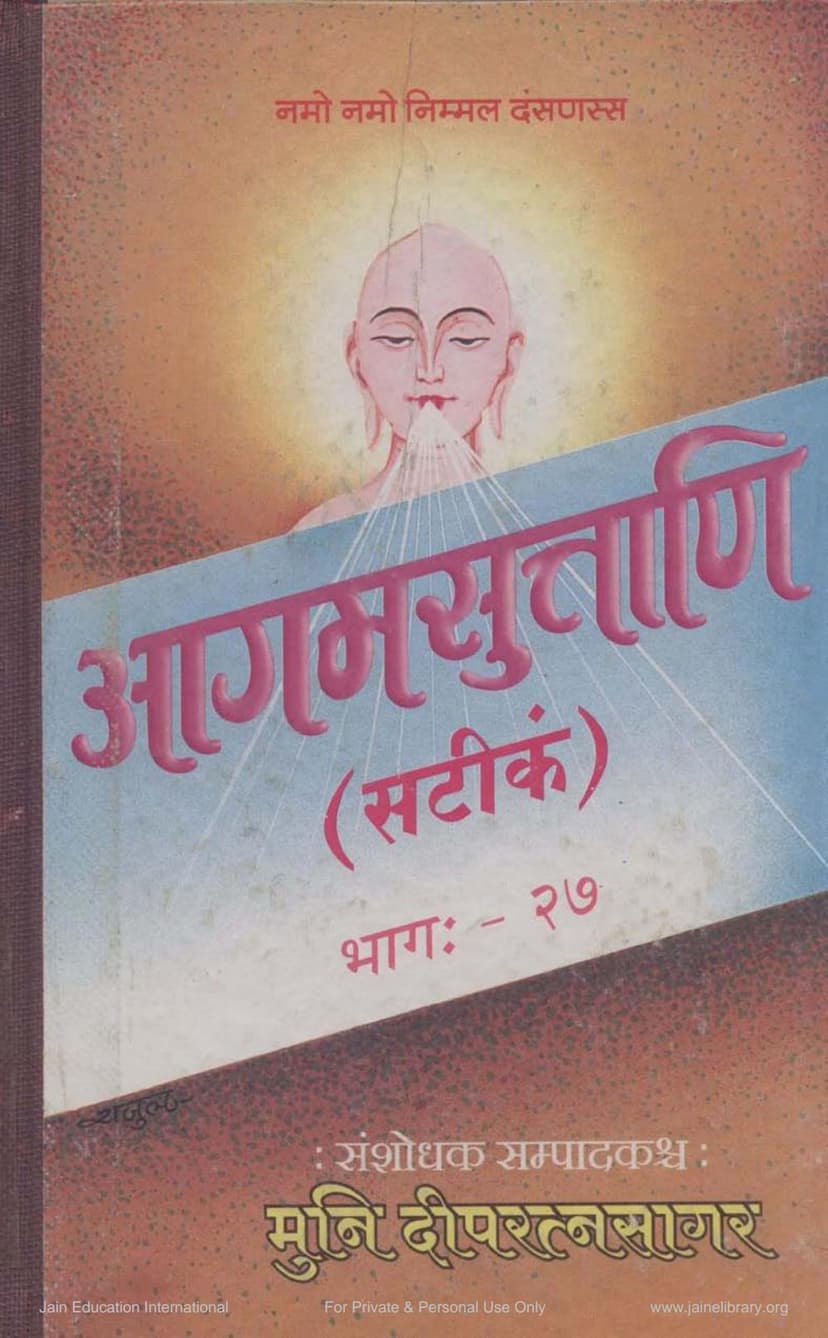Agam Sutra Satik 42 Dashvaikalik MoolSutra 3
Added to library: September 1, 2025

Summary
This document is a comprehensive summary in English of the Jain text "Agam Sutra Satik 42 Dashvaikalik MoolSutra 3". The provided text is primarily in Gujarati and Sanskrit with some Prakrit, and it details the structure, content, and commentaries of this significant Jain scripture.
Here's a breakdown of the summary, covering the key aspects of the text:
1. Book Identification:
- Title: Agam Sutra Satik 42 Dashvaikalik MoolSutra 3
- Author(s): Muni Dipratnasagar, Deepratnasagar
- Publisher: Agam Shrut Prakashan
- Catalog Link: https://jainqq.org/explore/003380/1
- Note: "JAIN EDUCATION INTERNATIONAL FOR PRIVATE AND PERSONAL USE ONLY" is prominently displayed, indicating the restricted nature of the distribution.
2. Structure and Content (Detailed breakdown of the Dashavaikalik Sutra): The text meticulously outlines the structure of the Dashavaikalik Sutra through its table of contents (विषयः), which lists each Adhyayan (chapter) and its corresponding Moolank (root number/identifier) and page number. The Sutra is divided into ten chapters, followed by two Chulikas (appendices or supplementary chapters).
Here's a summary of the chapters and their general themes as indicated by the titles:
- Adhyayan 1: Drumushpika (द्रुमपुष्पिका): This chapter seems to deal with general principles or auspicious beginnings, possibly related to the beauty or nature of things, as suggested by the name "Drumushpika" (flower of a tree).
- Adhyayan 2: Shramanyapurva (श्रामण्यपूर्वं): This chapter likely discusses the prerequisites or early stages of monastic life or asceticism.
- Adhyayan 3: Kshullikacharakatha (क्षुल्लिकचारकथा): This chapter is titled "Story of the Kshullika's conduct," suggesting it might narrate the conduct or discipline of a minor nun or a specific practice.
- Adhyayan 4: Shadjivanikaya (षड्जीवनिकाय): This chapter deals with the "Six Classes of Living Beings" in Jainism, a fundamental concept in Jain ethics and philosophy.
- Adhyayan 5: Pindaiṣaṇā (पिण्डैषणा): This chapter focuses on "The search for alms," a crucial aspect of Jain monastic discipline, likely detailing the rules and ethics of collecting food.
- Adhyayan 6: Mahacharalatha (महाचारकथा): Titled "Story of the Great Conduct," this chapter likely elaborates on the elevated or important conduct of monks.
- Adhyayan 7: Vakyaśuddhi (वाक्यशुद्धि): This chapter is about "Purity of Speech," emphasizing the importance of right speech in Jainism.
- Adhyayan 8: Acharapraṇidhi (आचारप्रणिधी): This chapter deals with "Auspicious Conduct" or "Discipline in Conduct," likely outlining guidelines for righteous living.
- Adhyayan 9: Vinaya Samadhi (विनय समाधि): This chapter focuses on "Modesty and Equanimity," highlighting the virtues of humility and mental composure.
- Adhyayan 10: Sabhikṣuḥ (सभिक्षुः): This chapter is about "The Monk," likely describing the ideal qualities, duties, and lifestyle of a Jain monk.
Chulikas (Appendices):
- Chulika 1: Ratīvākyam (रतिवाक्यं): This likely discusses speech related to pleasure, attachment, or worldly enjoyments.
- Chulika 2: Vivikta Charyā (विविक्त चर्या): This chapter focuses on "Solitary or Secluded Conduct," possibly detailing the practices of monks living in isolation.
3. Commentary and Editing:
- The text explicitly mentions that it is Satik (सटीकं), meaning it includes a commentary (ṭīkā).
- Munishri Dipratnasagar is credited as the Sanshodhak (researcher) and Sampadak (editor) of this edition.
- The commentary (vyākhyā) is attributed to Haribhadrasuri (हरिभद्रसूरि), who authored the Vṛtti (वृत्त्ति), indicating a layer of scholarly interpretation.
- The Niyukti (नियुक्ति), a primary explanatory commentary, is attributed to Bhadravāhusvāmi (भद्रबाहुस्वामि), and the Bhāṣya (भाष्य) is also mentioned, likely indicating earlier layers of commentary.
4. Publisher and Contact Information:
- Publisher: Agam Shrut Prakashan (आगम श्रुत प्रकाशन)
- Contact Address: "Agam Ārādhana Kendra" (आगम आराधना केन्द्र), Ahmedabad, Gujarat.
5. Spiritual and Reverential Content:
- The text begins with devotional salutations: "Namo Namo Nirmal Dasaṇassa" (नमो नमो निम्मल दंसणस्स - Salutations to pure knowledge/perception) and salutations to revered gurus like Anand-Kṣamā-Lalit-Susheel Sudharmasagar Guru.
- It also invokes "Bālabrahmacārī Shri Nemināthāya Namaha" (बालब्रह्मचारी श्री नेमिनाथाय नमः - Salutations to the eternal celibate Neminath).
6. Financial Contributors (Ārthik Anudātā - આર્થિક અનુદાતા): The text lists several individuals and organizations who provided financial support for the publication. This demonstrates the community's involvement and support for the dissemination of Jain scriptures. The list includes names of donors and the specific contributions made (e.g., for copying the text).
7. Key Concepts and Structure of the Commentary: The commentary (likely the Vṛtti by Haribhadrasuri, built upon the Niyukti by Bhadrabahu) explains the Mool Sutra (original text) verse by verse. The introduction (Upo'dghāta-Niyukti - उपोद्घात-नियुक्तिः) details the importance of the scripture, the author's respect for the lineage of Jain Acharyas, and the methodology of interpreting such sacred texts. It often refers to other Jain scriptures like the Āvaśyaka Sūtra for detailed explanations, indicating an interconnected body of Jain literature. The Niyukti itself is presented as a structured explanation of the Mool Sutra, often through gathās (verses), which the commentary then elucidates.
In essence, this document is not just a summary of the Dashavaikalik Sutra but a detailed overview of its commentary and the surrounding scholarly and devotional context of its publication. It highlights the reverence for tradition, the meticulous nature of Jain scholarship, and the importance placed on understanding these scriptures for spiritual progress.